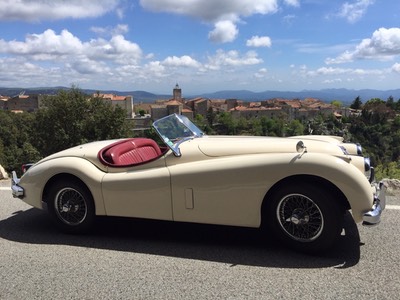Der XK120 war sehr erfolgreich, inkl. le Mans. Der XK140 (mit dem C Motor und dem H8 , Vergaser, den es bereits als winning engine beim 120er gab) war praktisch unverändert, hatte jedoch eine bessere Aufhängung und 7 cm mehr Innenraum sowie die praktischere Anordnung des Lenkrades.
Story:
1949
First race victory: In the Daily Express-sponsored One-Hour Production Car Race held on 30 August 1949 at Silverstone Circuit, England, Leslie Johnson drove the Jabbeke car to the XK120's first-ever race victory (despite an early collision with a spinning Jowett Javelin which dropped the Jaguar to fifth).[7] The car, road-registered HKV 500, was converted to right-hand drive for Silverstone. Two other XK120s took part. One, driven by Peter Walker, finished second and the other, driven by Prince Bira, spun out of contention when a tyre punctured.
1950
First victory in America: In January 1950 Johnson also scored the model’s first competition success in America, winning the production class in a race at Palm Beach Shores, Florida with the car that had finished second at Silverstone. The Jaguar lost its brakes but finished fourth overall. John Lea, Jaguar’s Experimental Department mechanic who attended the race, reported: "The conditions at Palm Beach were wet, windy and sandy. Water and sand gained entry into the brake drums at the front, and the mixture had the effect of accelerating the wear very considerably. Our car finished with no linings and with the steel shoes bearing on the brake drums."[7]
Pebble Beach Cup: In May, XK120s driven by Phil Hill and Don Parkinson finished first and second in this event at the inaugural Pebble Beach Road Races in 1950.
In 1950 Jaguar allocated six alloy-bodied XK120s to drivers Johnson, Walker, Nick Haines, Clemente Biondetti, Ian Appleyard and Tommy Wisdom.
Le Mans: Three of the allocated cars, extensively modified, entered the 1950 Le Mans 24 Hours race. Johnson, who spearheaded this factory-supported assault on the race with co-driver Bert Hadley, never ran lower than seventh place, and held second for two hours, but in the 21st hour had to retire from third place with clutch failure caused by using the gears to slow the car in the absence of brakes. (As a result the clutch was revised to a more robust design for production models.) The Jaguar had been closing the gap to leader Louis Rosier, whose Talbot's pace was significantly slower, at a rate that would have secured victory.[13] Haines, with co-driver Peter Clark, finished 12th, and Walker’s car, driven by Peter Whiteheadand John Marshall, was 15th.[7] The results convinced William Lyons it was worth investing in future success at Le Mans.[14]
Targa Florio: Biondetti's car, the first XK120 to contest the Targa Florio, lay second to Alberto Ascari’s Ferrari when a connecting rod broke, ending the Jaguar’s run.
Mille Miglia: Johnson took fifth place in the Mille Miglia, with John Lea as his riding mechanic, while Biondetti and co-driver Gino Bronzoni finished eighth. Fifth was an outstanding achievement for a production car, with Johnson's Jaguar beaten only by Fangio's works Alfa Romeo and the works Ferraris of Serafini, Bracco and winner Marzotto. It was Jaguar's best-ever finish in the Mille Miglia; also the best by a British car and driver combination, a feat that only Reg Parnell ever equalled, driving an Aston Martin DB3 in 1953.[15]
Silverstone Production Car Race: Five XK120s entered the race, which Peter Walker won from Tony Rolt, with Johnson recovering to eighth after spinning on oil. Jaguar won the team prize.
Tourist Trophy: XK120s also achieved a 1–2–3 victory in the TT, held at Dundrod in heavy rain. On the eve of his 21st birthday Stirling Moss drove Tom Wisdom's car to a brilliant win ahead of Whitehead and Johnson, and Jaguar once again took the team prize.[7]
This 1950 XK120 roadster won a Coupe des Alpes and a Coupe d’Or Alpine Rally: Ian Appleyard's XK120, road-registered as NUB 120, won the Alpine Rallywith his wife Pat, who was the daughter of Sir William Lyons, navigating. They also won a coveted Coupe des Alpes.[7]
1951
Alpine Rally: NUB 120 and the Appleyards repeated their previous year's success.
Tulip Rally: The Appleyards took first place in the Tulip Rally, with Swiss fighter pilot Rolf Habisreutinger’s XK120 finishing second.
1952
Alpine Rally: Although the Appleyards’ XK120 did not win its third Alpine, it completed the rally without incurring a single penalty point, winning the first-ever Coupe d'Or (Gold Cup).
1954
Mount Druitt 24 Hours Road Race: On 1 February 1954, an XK120 FHC driven by Geordie Anderson, Chas Swinburne and Bill Pitt won Australia's first 24-hour motor race, the 1954 Mount Druitt 24 Hours Road Race from a Bristol 400 and a Humber Super Snipe.
NASCAR road race: In America, an XK120 FHC was the first imported car to achieve victory in NASCAR, when Al Keller[16] won the first NASCAR road race, held at Linden Airport, New Jersey, on 13 June 1954.
XK 120 3.4 SE (C-Type Head) ("MC" in USA)1951–1954
3442 cc
DOHC Straight-6
83 mm/106 mm
Double SU H8 210 bhp (157 kW; 213 PS) @ 5750 rpm
